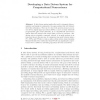Free Online Productivity Tools
i2Speak
i2Symbol
i2OCR
iTex2Img
iWeb2Print
iWeb2Shot
i2Type
iPdf2Split
iPdf2Merge
i2Bopomofo
i2Arabic
i2Style
i2Image
i2PDF
iLatex2Rtf
Sci2ools
ICCS
2004
Springer
2004
Springer
Developing a Data Driven System for Computational Neuroscience
Abstract. A data driven system implies the need to integrate data acquisition and signal processing into the same system that will interact with this information. This can be done with general purpose processors (PCs), digital signal processors (DSPs), or more recently with field programmable gate arrays (FPGAs). In a computational neuroscience system that will interact with neural data recorded in real-time, classifying action potentials, commonly referred to as spike sorting, is an important step in this process. A comparison was made between using a PC, DSPs, and FPGAs to train a spike sorting system using Gaussian Mixture Models. The results show that FPGAs can significantly outperformed PCs or DSPs by embedding algorithms directly in hardware.
| Added | 01 Jul 2010 |
| Updated | 01 Jul 2010 |
| Type | Conference |
| Year | 2004 |
| Where | ICCS |
| Authors | Ross Snider, Yongming Zhu |
Comments (0)

